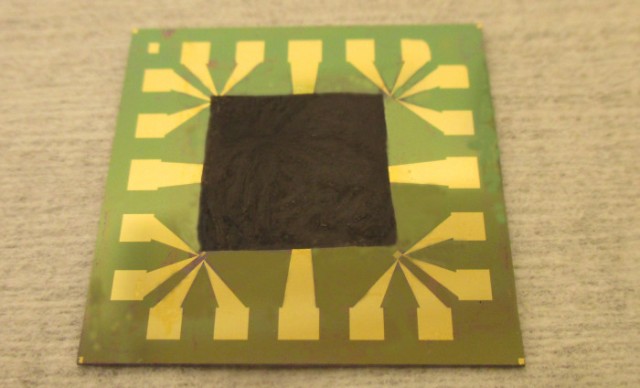Jul 13 2015
 Graphene-based film on an electronic component with high heat intensity. Image: Johan Liu
Graphene-based film on an electronic component with high heat intensity. Image: Johan Liu
The graphene-based film has a significantly higher thermal conductivity when compared to copper and can also be attached to silicon-based electronic components. Silicon favors the performance of graphene film in comparison to usual graphene properties shown in similar experiments performed in the past.
Current generation of electronic systems tend to build up considerable amount of heat, mainly because of the rising demand on functionality. For a higher electronic lifespan, it is important to eliminate excess amount of heat in an efficient manner. This would also reduce energy usage to a large extent.
According to a study carried out in the US, about 50% of the energy needed to operate computer servers is utilized just for cooling purposes alone. Two years ago, Johan Liu, professor at Chalmers University of Technology, headed a research team which was the first to demonstrate that graphene can render a cooling effect on electronics made of silicon. This discovery was the initial point for scientists performing studies on effective cooling of silicon-based electronics through graphene.
“But the methods that have been in place so far have presented the researchers with problems”, Johan Liu said. “It has become evident that those methods cannot be used to rid electronic devices off great amounts of heat, because they have consisted only of a few layers of thermal conductive atoms. When you try to add more layers of graphene, another problem arises, a problem with adhesiveness. After having increased the amount of layers, the graphene no longer will adhere to the surface, since the adhesion is held together only by weak van der Waals bonds."
“We have now solved this problem by managing to create strong covalent bonds between the graphene film and the surface, which is an electronic component made of silicon,” he continues.
The so-called fictionalization of graphene, that is, the inclusion of a property-changing molecule results in stronger bonds. The researchers tested a number of additives and finally arrived at the conclusion that when (3-Aminopropyl) triethoxysilane (APTES) molecules are added, they have the most favorable effect. Upon heating and subjecting to hydrolysis, the molecules produce silane bonds between the electronic component and graphene. Fictionalization through silane coupling also increases the graphene’s thermal conductivity significantly.
The Chalmers scientists have demonstrated that the in-plane thermal conductivity of a 20µm-thick graphene film can reach 1600W/mK, a thermal conductivity value that is four times higher than copper.
“Increased thermal capacity could lead to several new applications for graphene,” says Johan Liu. "One example is the integration of graphene-based film into microelectronic devices and systems, such as highly efficient Light Emitting Diodes (LEDs), lasers and radio frequency components for cooling purposes. Graphene-based film could also pave the way for faster, smaller, more energy efficient, sustainable high power electronics."